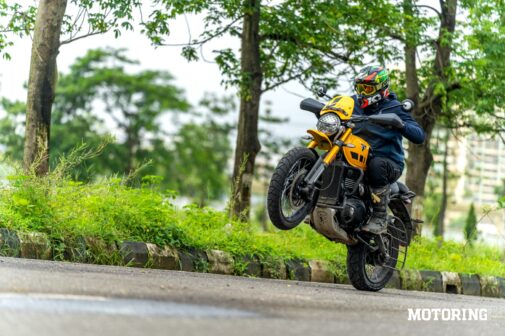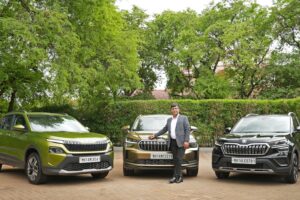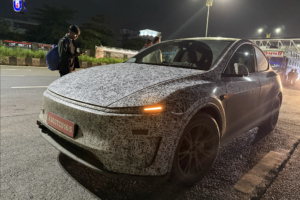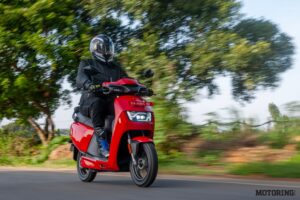The thrill of being on track is something truly unparalleled, and although we weren’t born in leathers with helmets strapped on, the track feels more like home to us than anything else. It’s probably how we are crouched in a foetal position on our motorcycles, pushing as hard as we can, rocking from side to side at breakneck speeds. It all sounds too similar to instances of what people call the miracle of life, but to most of us, it is exactly that. You’ll never feel more alive than when you’re astride a motorcycle, the throttle pinned as you make precise calculations and adjustments so as to better the person ahead of you, or, in all fairness, yourself.
As much fun as all of this sounds to the majority of us, there’s always the fact that we need to first learn how to walk before we can run, and that is where the Royal Enfield Track School comes into play. And as always, when it comes to learning, you can’t be trying to learn something new with a cup that is almost full. Empty your cup, unlearn what you may think you know, and start out with a clean slate. As our instructor, Anish Shetty, said, all you need to know is how to ride a motorcycle, and they’ll take care of the rest.
Starting off with a quick round of introductions with our fellow classmates, we were quickly taken to do a few drills to perk up our senses. After that, we sat down in the classroom for a quick session to brush up on our knowledge of track etiquette, flags, and other important things to keep in mind while on track. Considering that the only means of communication while on the track was through the flags, this warranted our full attention. Soon we suited up and were sent out onto the track for a few laps. This was basically to get us comfortable on track with the GT 650s while also enabling the instructors to pinpoint exactly what mistakes and bad habits we were bringing along with us to the class.
As we rolled into the pits, we were quickly ushered off the motorcycles, and the second batch quickly got on and set out. We were given a short break before being called back to the classroom. This time we were taught about the racing line, braking points, and the different sections to keep in mind while approaching a corner. Vision was also an important topic that we were briefed about, like how far into a corner your line of sight has to align and what happens if your vision is off. We were also told about stuff like target fixation and tunnel vision and what could go wrong in case it happened to us. Just casual stuff we need to be aware of.
That being said, we were sent back out on the track to implement what we had learned, under the watchful eyes of our instructors. Having memorised the lines I was supposed to follow, I managed to keep a pretty decent pace with those in front of me, and since I was pretty confident with the brakes, I was braking late and closing the gap between us. My vision seemed to be better, considering I was deliberately focusing on keeping it in line with the furthest point into the corners. It’s most often the small things that help you shave off milliseconds, and that makes a whole lot of difference in the long run.
As we made our way back into the pits once again, I realised that, while almost everything else felt okay, my body positioning still seemed off, and my right knee was just not opening up into the corner. Classes had come to a close for the day, but the instructors were still very welcoming to questions thrown at them from any point during the day. Learning is surely made easier in an open and comfortable environment where all questions are welcome.
The next day started off with a few quick stretches, after which we were taken on a track walk so that we could get a better insight into the surface, marker points, and the proper lines to follow. As soon as that was done, we kitted up, and Anish started us on braking and counter-steering drills. It was extremely interesting to see how the GT 650 reacted to conscious counter steering input — while most of the time counter steering just happens naturally on the go.
Having finished those drills, we were sent out on track to implement what we had learned, with instructors keeping a close eye on us. Without leaning my body into the corner, subtle inputs to the handlebar saw to it that the motorcycle tipped into the corner almost fluidly. It was a weird feeling, but exciting nonetheless. Next, we learned about proper body position and the science behind it when it comes to the racetrack. The next track session saw us implement this too.
Then, once we had mastered both individually (well, sort of), combining the two saw to it that we hit some insane lean angles, where we were able to carry much more speed into the corners as well as out of them. In our final classroom session, Anish told us that in a one-make race, all the bikes are the same and will fare equally on the straight. A racer gains or loses time only in the corners, and during a race, hopefully the former.
It’s almost always just a process of trying to do better than your previous attempt because it’s not enough to be consistent; you need to be better each time around. At the Royal Enfield Track School, I have managed to walk out as a better rider than when I walked in, so that’s a huge success on my part. If you look at it that way, the science of speed isn’t really that complicated, as long as you have the right formula.
























